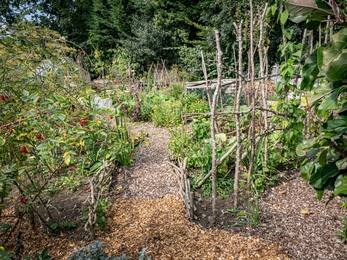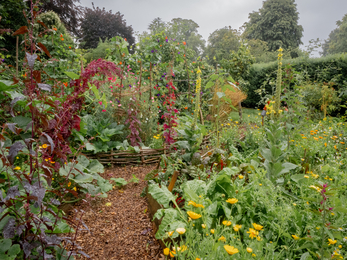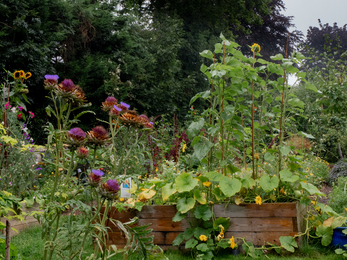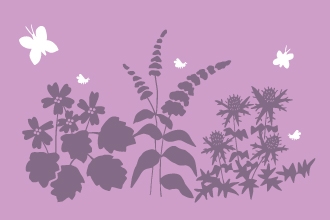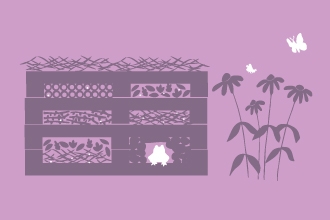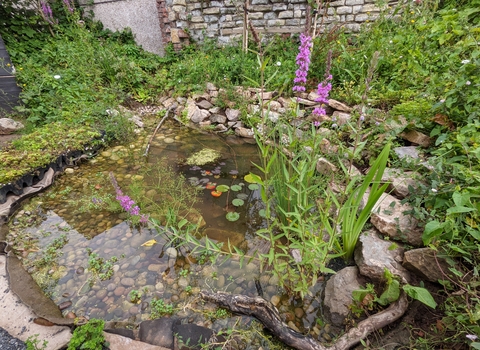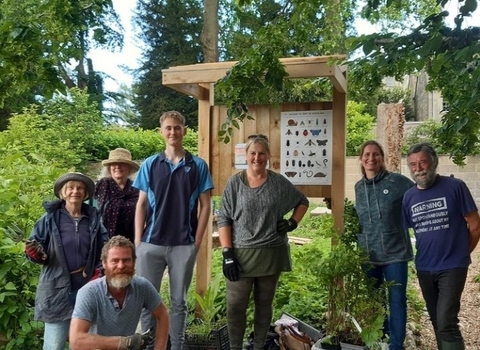
Stephanie Chadwick
Alice Park Community Garden
Alice Park Community Garden
Name: Alice Park Community Garden
Category: Community space in 2023 and 2024
Area: Bath, BA1
Alice Park won the OUTSTANDING AWARD in the wildlife gardening competition 2024 and were finalists in 2023!
What makes your garden wildlife friendly?
We are an organic, no-dig vegan garden. We do not use any artificial pesticides, herbicides or other chemicals that harm wildlife. We make space for nature. We use sustainable horticultural techniques like mulching, green manures and biochar that build soil health, promote healthy populations of soil microbes and support a diverse 'food chain' in the garden.
We are content to grow food to share with our volunteers and our voracious molluscs, flea beetles, caterpillars and other wee beasties. We encourage self-seeding pollinator plants such as marigolds, scentless chamomile, fennel, love-in-the-mist and native wildflowers as well as extending the season for pollinators by having early- and late-flowering plants such as ivy, lungwort, spring bulbs and fruit tree blossom.
Edges are left untouched. We do no-mow May on our grassy areas, there are bee hotels, twiggeries, beetle banks and we collect fallen leaves for leaf mould and encourage leaf litter refuges in the forest garden. We have a bird box, provide lots of shelter and we refrain from pruning back the berry-bearing trees and shrubs for winter bird food. The forest garden is designed to fend for itself, with plenty of wildflower species amongst the ground cover.
Tell us what you love about your garden
Alice Park Community Garden is open 24/7 and is well-used by local people, as somewhere to sit, to learn about vegan organic food growing and forest gardening, to attend a workshop on a gardening/cooking/ wildcrafting theme and somewhere to socialise, connect with nature and enjoy being outdoors.
The garden has been tended by volunteers for 12 years and is a demonstration garden showing eg water saving techniques, composting, promoting soil health, befriending microbial life, using cover crops, green manures, seed saving and other sustainable techniques whilst maintaining spaces for wildlife to forage, shelter, breed and find refuge.
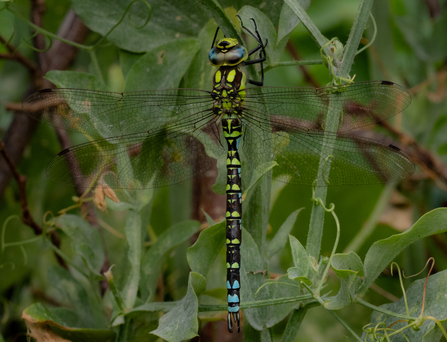
Stephanie Chadwick
What wildlife have you seen in your garden?
The garden is a small area where we aim to make space for nature in what we do and how we grow. We have an established wildlife pond with frogs, newts, damselflies and dragonflies, grass snake and lots of aquatic invertebrates; bird life includes breeding great tit, nuthatch, as well as occasional green woodpecker, pied woodpecker, gold crest, collared dove and treecreeper. Regular visitors include blackbirds, dunnock, blue tit, goldfinch, robin, chaffinch, wood pigeon, wren.
We have a lot of insects as we grow a lot of pollinator-friendly plants: hoverflies, mason bees, leaf cutter bees, other solitary bees, wasps, drone flies, lots of different bumblebees and beetles. We occasionally come across a toad, there's a badger run across the garden, a badger latrine, short-tailed voles, fox, and bats overhead.
The compost heap is a world of invertebrate wonders and earthworms. We encourage native wildflowers in the forest garden and beneath the fruit trees to support pollinators. We have lots of nettles, brambles and log piles which tend to be left well alone, for the decomposers and beetles. We have elder, dog rose, climbers and fruit trees providing a larder for birds and small mammals.
Alice Park Community Garden were a finalist!

John Seager
Lack of disturbance is a key feature of success in our garden. It's also important to recognise that untidiness creates lots of niches that encourage greater biodiversity. Providing food sources, shelter, water and somewhere to breed will bring a garden alive and make it a better place for everyone to enjoy.Alice Park Community Garden
Feeling inspired?
The Team Wilder Community Ecologist visited Alice Park Community Garden. Here is some of the advice shared and actions you can take for nature in your garden or community spaces.
Leaving the grass to grow long The grass along the margins of the hedgerow and around the tree could be left long through the winter to provide shelter for invertebrates, amphibians, reptiles and small mammals such as hedgehogs. The long grass by the tree and hedgerow could be connected up to ensure a corridor is present for wildlife too. The grass can be cut on rotation (e.g. a different part could be cut every 2-3 years) so that it does not become rank over time. Dead wood could be put into this long grass to act as another habitat feature.
Mini meadow A meadow could be created within the existing amenity grassland at the front of the community garden. Either just sow yellow rattle into the ground whilst carrying out a suitable management regime (e.g. cutting late summer and removing the arisings) or you could choose a wildflower mix to sow. I have included a few factors to consider for yellow rattle which will influence the success:
- The seed needs to be sown in the autumn (as yellow rattle requires a prolonged period of cold weather to trigger germination) and have good contact with the soil. The seedlings will grow in early March and therefore the area should not be mown to allow for this growth.
- The seeds need to be fresh (harvested from the current season) as it has short term viability. The suppliers below ensure that the seed is fresh when bought and therefore the seed should then be sown quickly after purchase in autumn.
- Yellow rattle needs low to medium fertility and find it difficult to establish is areas dominated by coarser/’tussocky’ grasses (e.g. cock’s foot and perenial ryegrass) as the plant is not robust enough to out compete these grasses.
If you choose to include other species into the mix then the wildflower meadow can be sown with wildflower seeds and/or planted with plug plants in the autumn or spring. Ensure that the grass is mown very short within the area before you want to sow the seed. Collect the arisings immediately so that the nutrients don’t leach back into the soil (wildflowers grow well in low nutrient soils). Then create at least 50% bare ground by raking or using a hand scarifier. You could invite the community along to help sow the seeds into the grassland and therefore engage them with the process.
Team Wilder community wildflower meadows
Mini meadows at home
Paths Once the mini meadow is established, paths could be mown through to allow the public to access the meadow and to also enter the community garden. People generally stick to the formal paths rather than walking on the meadow itself and therefore there should not be issues with trampling. You could even create dead hedging alongside the paths if you prefer a more formal barrier that is still natural (resources can be found below).
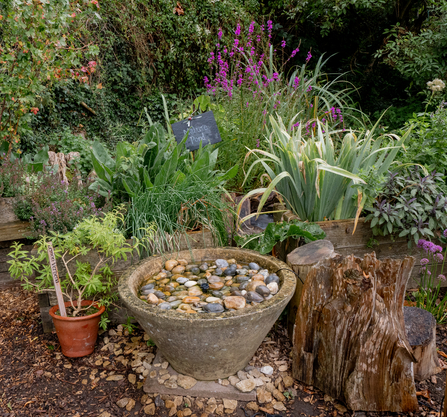
Stephanie Chadwick
Bird and bat boxes I recommend that additional bird and bat boxes are installed on the trees/fences/buildings on site. Bird boxes should go on the northern or eastern elevations and bat boxes should go on the southern or eastern elevations.
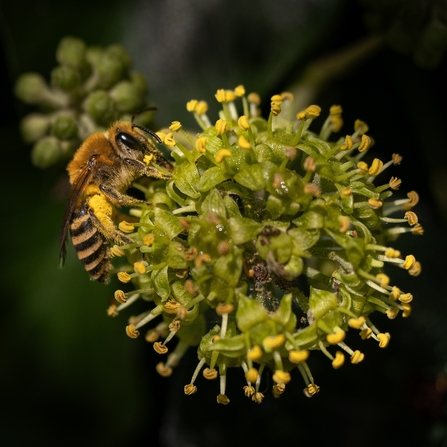
Stephanie Chadwick
Resources
Be part of Team Wilder
Feeling inspired by this wildlife garden? Try something for yourself at home, in your community, school, business or land, no matter the size.
All actions for nature collectively add up and makes a difference for people and wildlife.
Share your actions for nature, like Alice Park Community Garden, and motivate others to do the same.
Log your actions for nature on the map

